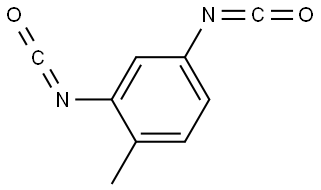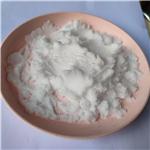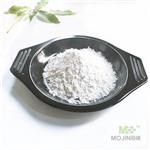Chemical Properties
2,4-Diaminotoluene is an organic compound with the formula C6H3(NH2)2CH3. It is one isomer of six with this formula. It is a synthetic, colorless to brown crystalline solid that is soluble in water, ethanol, ether and benzene. It is used primarily as an intermediate in the production of toluene diisocyanate, which is used to produce polyurethane.
Uses
2,4-diaminotoluene is used primarily in the production of 2,4-toluene diisocyanate, which is used in the production of polyurethane. It is used as an intermediate in the synthesis of dyes and heterocyclic compounds. 2,4-Diaminotoluene has been used as a developer for direct dyes, particularly to obtain black, dark blue, and brown shades, and to obtain navy blue and black colors on leather. Other applications include the preparation of impact resins, polyamides with superior wire-coating properties, antioxidants, hydraulic fluids, urethane foams, and fungicide stabilizers, and as a photographic developer (HSDB 2009).
Definition
ChEBI: 2,4-diaminotoluene is an aminotoluene that is para-toluidine with an additional amino group at position 2. It has a role as a metabolite. It derives from a p-toluidine.
Preparation
2,4-Diaminotoluene is prepared by hydrogenation of 2,4-dinitrotoluene using a nickel catalyst. Commercial samples often contain up to 20% of the 2,6-isomer.
General Description
A colorless crystalline solid. Toxic by ingestion and inhalation. Irritates skin and eyes. Slightly soluble in water and neutrally buoyant in water. Decomposes with emission of toxic oxides of nitrogen at high temperatures. Used in making dyes.
Air & Water Reactions
Soluble in water, alcohol and ether.
Reactivity Profile
2,4-Diaminotoluene neutralizes acids in exothermic reactions to form salts plus water. May be incompatible with isocyanates, halogenated organics, peroxides, phenols (acidic), epoxides, anhydrides, and acid halides. May generate hydrogen, a flammable gas, in combination with strong reducing agents such as hydrides. Reacts vigorously with oxidizing agents [USCG, 1999].
Health Hazard
2,4-Toluenediamine is a cancer-causing compound. Animal studies indicate sufficient evidence of its carcinogenicity. Oral applicationof this amine resulted in blood and liver cancers in rats and mice.
The acute oral toxicity was moderate tohigh in test animals. It produced methe moglobinemia, cyanosis, and anemia. Theoral LD50 value in rats is 250–300 mg/kg.It is a mild skin irritant. The irritation effecton rabbits'eyes was moderate.
Acute (short-term) exposure to high levels of toluene-2,4-diamine in humans has caused severe skin and eye irritation sometimes leading to permanent blindness. Other effects include respiratory problems, stomach gas, rise in blood pressure, dizziness, convulsions, fainting, and coma.
Fire Hazard
Noncombustible solid. It ignites when mixed
with red fuming nitric acid. Reactions with strong oxidizers and hypochlorites can be
violent.
Flammability and Explosibility
Non flammable
Safety Profile
Confirmed carcinogen
with experimental carcinogenic data. Poison
by intraperitoneal and subcutaneous routes.
Experimental reproductive effects. Human
mutation data reported. A skin and eye
irritant. This material has a marked toxic
action upon the liver and can cause fatty
degeneration of that organ. When heated to
decomposition it emits toxic fumes of NOx.
See also other toluenediamine entries and
AROMATIC AMINES.
Potential Exposure
2,4-Diaminotoluene can be found in flexible and rigid polyurethane foams, upholstery, polyurethane coatings, for dyes used on textiles, leather, furs, in hair-dye formulations, sealants, adhesives gums and fibers. The substance is also commonly used when manufacturing other substances.
Carcinogenicity
2,4-Diaminotoluene is reasonably anticipated to be a human carcinogen based on sufficient evidence of carcinogenicity from studies in experimental animals.
Shipping
UN1709 2,4-Toluylenediamine, solid or 2,4Toluenediamine, solid, Hazard Class: 6.1; Labels: 6.1-Poisonous materials. UN3814 2,4-Toluylenediamine, solution or 2,4-Toluenediamine, solution, Hazard Class: 6.1; Labels: 6.1-Poisonous materials.
Purification Methods
Recrystallise the diamine from water containing a very small amount of sodium dithionite (to prevent air oxidation), and dry it under vacuum. It also crystallises from *benzene. [Beilstein 13 IV 235.]
Incompatibilities
Strong acids; chloro formates, oxidizers.
Waste Disposal
Consult with environmental regulatory agencies for guidance on acceptable disposal practices. Generators of waste containing this contaminant (≥100 kg/mo) must conform with EPA regulations governing storage, transportation, treatment, and waste disposal. Controlled incineration (oxides of nitrogen are removed from the effluent gas by scrubbers and/or thermal devices).







